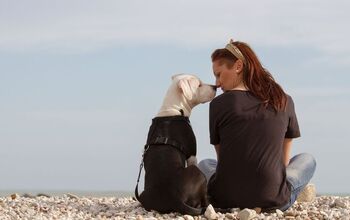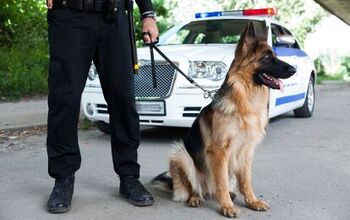Back To Basics: How To Outfit Your Pooch With The Right Dog Backpack

My favorite thing about back to school was getting a new backpack. And even though I’m too cool to go to school (except when I’m working there), I’ve transferred my love for pack wearable to my pack… of dogs. All of our dogs have sported a doggy backpack at some time or another, and I find them to be invaluable on our camping tips and hikes. And although your dog may not need to carry around a pencil case and binder, he may enjoy pulling his own weight during your next outing together.
If you’re in the market for a dog backpack, here are a few things to keep in mind before you buy:
Consider the Dog
Some dogs are simply more suited to packs than others. Physically fit, mature dogs, in good health, who are at least 30 pounds will be the best candidates for carrying some extra weight in a pack. A healthy dog, walking in ideal conditions, can carry 30 percent of his body weight. If it’s hot or humid outside, then you drop the weight of the pack accordingly.
Related: Top 5 Reasons To Go For An Autumn Hike With Your Dog
A dog’s temperament plays an important part as well – a happy, outgoing dog will enjoy the challenge of carrying a pack. If your dog is shy or nervous around other dogs, a pack may make him feel trapped, compelling him to defend himself when meeting new dogs. If your dog isn’t all that comfortable around other dogs, work with a trainer before adding a dog backpack.
Finding the Right Fit
When looking for a pack that’s a good fit, think about what you are planning to use it for. Pack price points range from $30 to over $100, so there is definitely something for every budget. A higher price doesn’t necessarily mean you need a fully loaded pack. Look carefully at the features you need, and expect to pay more for a larger dog.
Related: Rustic Tips To Remember When Camping With Dogs
If you are ordering online, check the return policy before you buy. Most of the packs sold for dogs are fully adjustable, but dogs come in so many different shapes and sizes. Even within a breed, it can be difficult to know if a pack will fit well without trying it on first.
Be a wise consumer, and remember your dog will be wearing the pack, not you. Some packs are designed to appeal more to people and may be less functional on the trail. Think of how you will be using the pack, and where. Does it need to be water resistant? How much gear will your dog be carrying? Is the leash attachment secure? These are all important questions before purchasing.
Getting Your Dog Used to a Pack
Some dogs take happily to carrying a pack, while others take some time to get used to it (and other dogs may just not be suited to it at all). To get your dog used to a pack, start slowly. First, let your dog examine the pack, and make this a really positive experience (lots of praise for sniffing and showing an interest in the pack). Do this a few times and always keep your tone positive when introducing him to the pack.
Before the pack goes on your dog’s back, make sure he’s already been on a decent walk. A calm, focused dog is much easier to fit properly. Ensuing that all the straps are tightened properly, lure your dog into moving with the pack on his back. Use some really tasty treats to get him moving, and your dog will begin to associate the pack with good things. During this time, you want to assess your dog’s comfort level. Nervous? Unsure? Ambivalent? Also watch as your dog moves about the house: does he have his normal range of motion? Are there straps hanging in the way of the legs? Are the saddlebags sitting far enough forward on the shoulders?
Once you have checked the pack and made any adjustments for fit, put it away for the day. You want to keep these sessions short and sweet. The next time the pack comes out you can take the dog for a short, fun walk. Bring plenty of treats and make this a pack party! You want the pack to be associated with really good things, so your dog is happy to carry it.
As your dog gets used to the pack, begin to fill the saddlebags with bunched up grocery store bags. You want to use something lightweight that will give the dog a feeling for the potential bulk of the pack. If you take your dog down a narrow trail or through a crowded farmers market, you don’t want the dog ramming the pack into people.
Over time, you can gradually increase the weight of items in the pack. Take care to always keep the pack balanced on your dog’s back. Before each use, give the pack a good once-over, looking for any frays or tears in the materials. Check that the buckles are clean and free of debris. Inspect your dog’s body for areas where a pack might be rubbing or causing hair loss. If the pack is rubbing, adjust it, and if that doesn’t fix the problem, get a different model.
Hot and Cold Weather
Extreme weather means you need to make special considerations for your dog. Your dog doesn’t have a voice in this, so if the pack is going to cause problems, don’t bring it. Carrying a pack is work, and even a pack with little weight will still trap some body heat, making your dog warmer with a pack than without. If the temperature and humidity are climbing, leave the pack at home. On that note, if it’s too hot out there, it might be better off that everyone stays home!
When the winter winds blow, test your pack out on trails close to home first. You want to ensure that the buckles and snaps hold up to cold weather. Don’t expect your dog to carry a pack in deep snow. Working through deep snow can quickly exhaust a dog, especially if they are carrying added weight.
If the snow is moist and sticky, check the pack and straps for ice balls forming against the dog’s skin. Not only are these painful, they can cause hair loss, which will lead to frostbite. I don’t ask my dogs to carry packs if we are going through deep snow.
Age, body type and condition all play a role in how you dog will tolerate extremes in weather. It might be disappointing to have to miss a trip, but better a minor disappointment than getting caught in an extreme situation where your dog needs medical assistance.
Leash in Hand
Regardless of how awesome your dog is off leash (or how awesome you think he is off leash), when you put a pack on your dog, it’s time to put the leash on. Not only does a leash allow you to help with a heavy pack over obstacles on the trail, it allows you to keep an eye on your dog. A dog who is lost in the woods with a pack on runs the risk of being trapped by the straps and bulk or exhausted. A dog carrying food or anything that might smell like food is a tempting target for hungry predators. Keeping your dog on a leash is the responsible decision.
Even on a leash and safe with you, there are still items you should avoid putting in your dog’s backpack. Anything essential should be carried by yourself. I have my dogs to carry some water, but the purification kit stays with me. Car keys and matches are always in my pack. I do pack dog food for each dog in their own packs, but it’s the extra food (just in case, I’m always prepared), and human food goes in mine. If something was to happen and I was separated from my dogs, I want to be able to survive so I can find them again!
What to Except When You Have a Dog in a Pack
Be ready for some extra attention. When people see your dog in a pack, you will be on the receiving end of comments, compliments and questions. If you and your dog are social butterflies, be prepared for many conversations about how cool it is that your dog is carrying some of the weight. And if your dog loves the attention, this helps to re-enforce that wearing a pack is a good thing!

Kevin Roberts lives for adventure. Together with his pack of rescue dogs and his husband, he spends as much time outdoors as possible. Kevin lives by the motto: "Get outside and play with your dogs!
More by Kevin Roberts


























